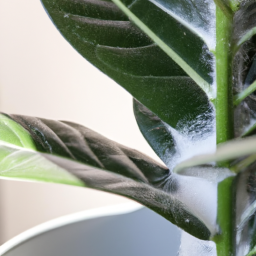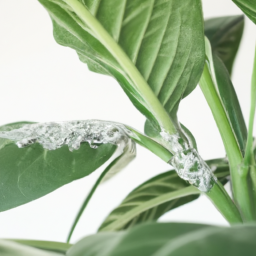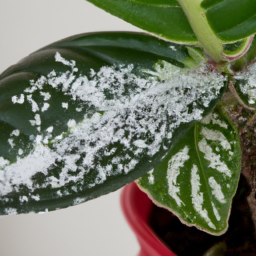
Have you ever noticed tiny white bugs on your indoor plants and wondered, “How do indoor plants get mealybugs?” Mealybugs are a common pest that can wreak havoc on your beloved houseplants if left untreated. In this blog post, we will explore the various ways mealybugs find their way onto indoor plants and what you can do to prevent and treat infestations. So grab your favorite plant and let’s dive in to learn more about these pesky pests.
Identifying Mealybugs on Indoor Plants
What are Mealybugs?
Mealybugs are small insects that are commonly found on indoor plants. They are soft-bodied insects that are covered in a white, powdery substance that gives them a mealy appearance. Mealybugs feed on the sap of plants by piercing the plant tissue with their needle-like mouthparts. They can be found on the leaves, stems, and even the roots of indoor plants. Mealybugs can quickly multiply and infest an entire plant if not dealt with promptly.
Signs of Mealybug Infestation
One of the most common signs of a mealybug infestation is the presence of white, cottony masses on the plant. These masses are actually the bodies of the mealybugs themselves, as they secrete a waxy substance to protect themselves. You may also notice a sticky residue on the plant, which is a result of the mealybugs excreting a sugary substance called honeydew. In addition, mealybugs can cause yellowing or wilting of the plant leaves, stunted growth, and even plant death if left untreated.
Preventing Mealybug Infestations
To prevent mealybug infestations on your indoor plants, it is important to regularly inspect your plants for any signs of pests. Quarantine new plants before introducing them to your existing plant collection to prevent the spread of pests. Keep your plants healthy by providing them with proper sunlight, water, and nutrients, as healthy plants are more resistant to pest infestations. Avoid over-fertilizing your plants, as this can attract mealybugs and other pests. If you do notice mealybugs on your plants, isolate the infested plant immediately to prevent the pests from spreading to other plants.

Preventing Mealybug Infestations in Indoor Plants
Understanding Mealybugs and How They Spread
Mealybugs are tiny, soft-bodied insects that feed on the sap of plants. They are often found in warm, humid environments, making indoor plants a perfect breeding ground for them. Mealybugs can spread to indoor plants through a variety of ways, including:
1. **Infested Plants:** One of the most common ways mealybugs spread to indoor plants is through infested plants. If you bring a new plant into your home that is already infested with mealybugs, they can easily transfer to your other plants.
2. **Contaminated Soil:** Mealybugs can also spread through contaminated soil. If you use soil that is infested with mealybugs for repotting your plants, you risk introducing the pests to your indoor garden.
3. **Airborne Infestations:** In some cases, mealybugs can be carried by the wind or other insects and land on your indoor plants. This is more common in outdoor plants that are brought inside.
To prevent mealybug infestations in your indoor plants, it is important to take proactive measures to keep these pests at bay.
Preventative Measures
1. **Inspect New Plants:** Before bringing a new plant into your home, inspect it thoroughly for any signs of mealybugs or other pests. Look for white, cottony masses on the leaves or stems, as this is a telltale sign of mealybug infestation.
2. **Quarantine New Plants:** If you suspect that a new plant may be infested with mealybugs, quarantine it away from your other plants for a few weeks to monitor for any signs of pests. This will help prevent the spread of mealybugs to your other indoor plants.
3. **Maintain Good Plant Hygiene:** Regularly clean and dust your indoor plants to remove any potential hiding spots for mealybugs. Keep your plants well-watered and fertilized to promote healthy growth and make them less susceptible to pests.
4. **Natural Predators:** Introduce natural predators of mealybugs, such as ladybugs or lacewings, to your indoor garden. These beneficial insects can help keep mealybug populations in check.
5. **Organic Pest Control:** If you do notice mealybugs on your indoor plants, consider using organic pest control methods, such as neem oil or insecticidal soap, to get rid of the pests. Avoid using harsh chemicals that can harm your plants and the environment.
By following these preventative measures, you can help protect your indoor plants from mealybug infestations and ensure a healthy, thriving indoor garden. Remember to regularly monitor your plants for any signs of pests and take action promptly to prevent further spread.

Treating Mealybug Infestations on Indoor Plants
Understanding Mealybugs and How They Infest Indoor Plants
Mealybugs are small, soft-bodied insects that are commonly found on indoor plants. They feed on the sap of plants by piercing the plant tissue with their needle-like mouthparts. Mealybugs are usually found in clusters on the stems, leaves, and undersides of leaves of indoor plants.
Mealybugs can infest indoor plants in several ways. They can be brought into your home on new plants or cuttings that you bring in from outside. They can also be carried in on clothing or pets that have been outside. Mealybugs can also be transferred from plant to plant if they are placed close together.
Once mealybugs have infested your indoor plants, they can quickly multiply and spread to other plants in your home. It is important to take action as soon as you notice signs of a mealybug infestation, such as white cottony masses on the plant or sticky honeydew residue on the leaves.
To treat a mealybug infestation on your indoor plants, you will need to take a multi-faceted approach. This may include physical removal of the insects, as well as the use of natural or chemical insecticides.
Physical Removal of Mealybugs
One of the first steps in treating a mealybug infestation on indoor plants is to physically remove the insects from the plant. This can be done by using a cotton swab dipped in rubbing alcohol to dab the insects directly. You can also use a soft brush to gently scrub the insects off of the plant.
Another method of physical removal is to spray the plant with a strong stream of water to dislodge the mealybugs. Be sure to do this in a sink or outside to prevent the insects from spreading to other plants in your home.
After physically removing the mealybugs, be sure to monitor your plants closely for any signs of a re-infestation. It may be necessary to repeat the physical removal process several times to completely eradicate the insects from your indoor plants.
Using Natural or Chemical Insecticides
If physical removal alone is not enough to treat a mealybug infestation on your indoor plants, you may need to use natural or chemical insecticides. There are several options available for treating mealybugs, including neem oil, insecticidal soap, and horticultural oil.
Neem oil is a natural insecticide that is derived from the neem tree. It works by disrupting the growth and development of mealybugs, ultimately leading to their death. Neem oil is safe to use on most indoor plants and is effective at controlling mealybug infestations.
Insecticidal soap is another natural option for treating mealybugs on indoor plants. It works by suffocating the insects and disrupting their cell membranes. Insecticidal soap is safe to use on most indoor plants and is effective at controlling mealybug infestations.
Horticultural oil is a petroleum-based product that works by smothering the mealybugs and disrupting their ability to feed. Horticultural oil is effective at controlling mealybug infestations on indoor plants, but it can be toxic to some plants, so be sure to read and follow the manufacturer’s instructions carefully.
In conclusion, treating a mealybug infestation on indoor plants requires a multi-faceted approach that may include physical removal of the insects, as well as the use of natural or chemical insecticides. By taking action as soon as you notice signs of a mealybug infestation, you can prevent the insects from spreading to other plants in your home and keep your indoor plants healthy and thriving.
Key Takeaways
Have you ever noticed tiny white bugs on your indoor plants and wondered where they came from? Those pesky little insects are called mealybugs, and they can wreak havoc on your beloved greenery if left unchecked. But how exactly do indoor plants get infested with mealybugs in the first place?
Mealybugs are notorious for hitching a ride into your home on new plants or even on items like soil, pots, or gardening tools. Once inside, these sneaky bugs can quickly multiply and spread to other plants, sucking the sap out of leaves and stems in the process. To prevent mealybug infestations, it’s essential to inspect new plants carefully before bringing them indoors and regularly check your existing plants for any signs of these unwelcome visitors. Remember, a little vigilance goes a long way in keeping your indoor jungle mealybug-free!
Your Questions Answered. Comprehensive FAQ:
Q1: How do indoor plants get mealybugs?
A1: Indoor plants can get mealybugs through a variety of ways, such as bringing infested plants into your home, using contaminated soil or pots, or even through open windows where mealybugs can enter.
Q2: What are the signs that my indoor plant has mealybugs?
A2: Signs that your indoor plant has mealybugs include white, cotton-like clusters on the leaves or stems, sticky residue on the plant, yellowing or wilting leaves, and stunted growth.
Q3: How can I prevent mealybugs from infesting my indoor plants?
A3: To prevent mealybugs from infesting your indoor plants, regularly inspect your plants for signs of infestation, quarantine new plants before introducing them to your collection, avoid overcrowding plants, and maintain proper plant care practices.
Q4: How do I get rid of mealybugs on my indoor plants?
A4: To get rid of mealybugs on your indoor plants, you can use natural remedies like rubbing alcohol or neem oil, physically remove the bugs with a cotton swab or cloth, or introduce predatory insects like ladybugs.
Q5: Are mealybugs harmful to my indoor plants?
A5: Yes, mealybugs can be harmful to indoor plants as they feed on plant sap, weakening the plant and causing damage like yellowing leaves, stunted growth, and even plant death if left untreated.

James Wong is a renowned ethnobotanist, plant scientist, and local television presenter. With a passion for demystifying plant science, he is known for translating complex botanical concepts into practical advice for everyday plant enthusiasts. James’s expertise spans from traditional gardening to cutting-edge plant technologies, making his insights accessible and informative.


